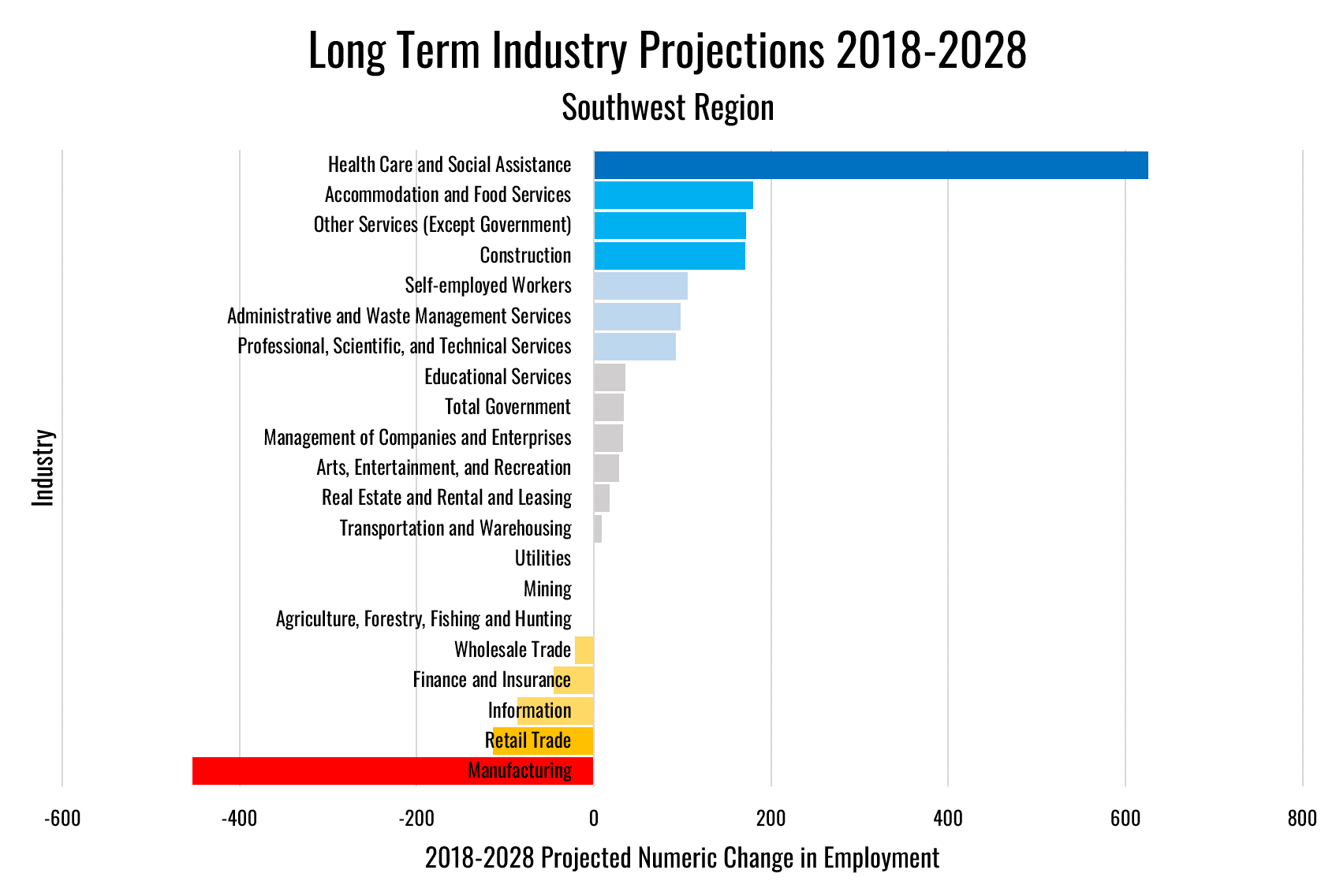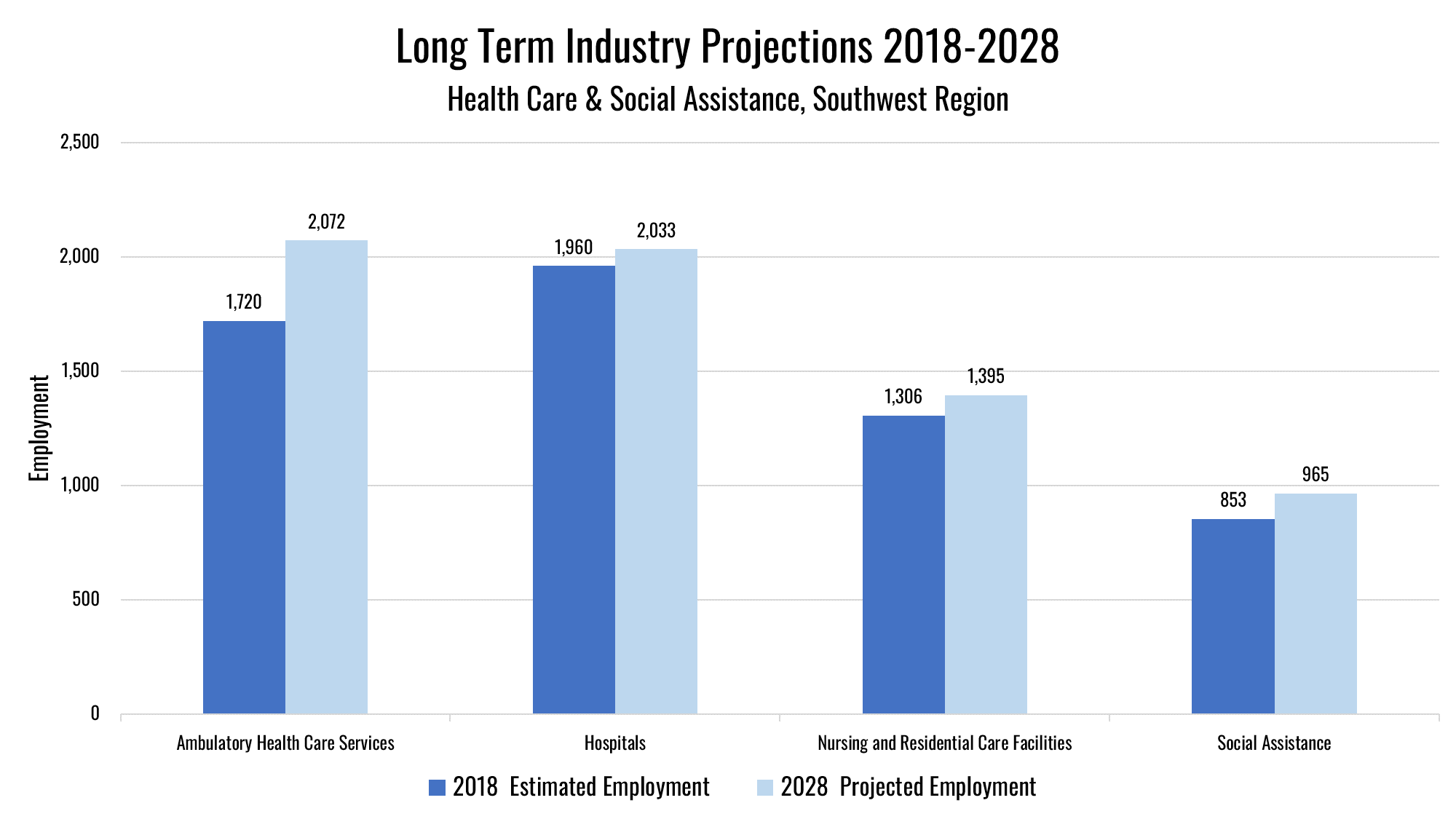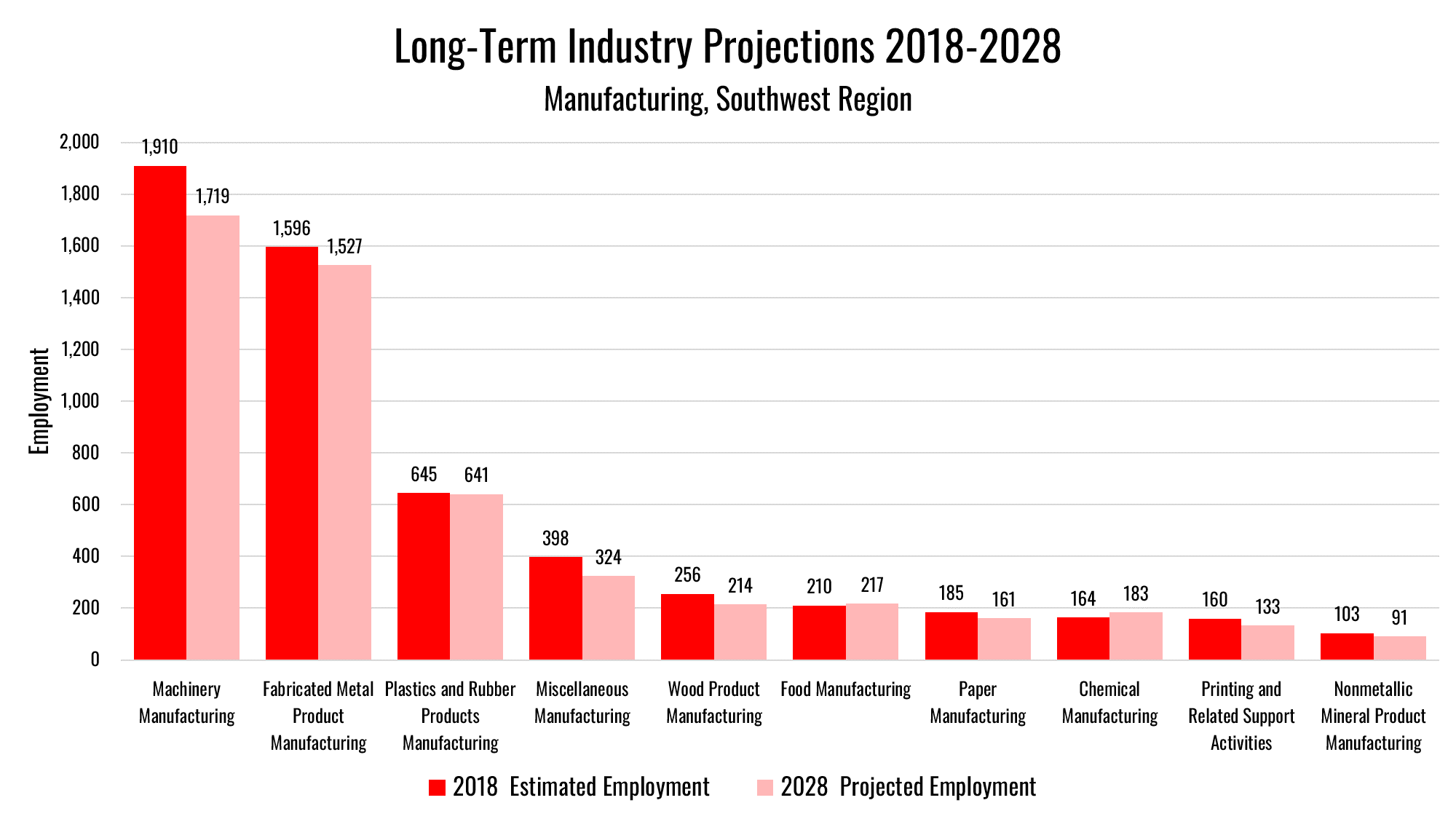Understanding local workforce needs and trends is an ever-present challenge for educators, employers, and policy makers but one that is critical to understanding the long-term health of a region’s economy. This challenge has been amplified by the initial shock and subsequent persistence of the COVID-19 pandemic. We have witnessed some of the most dramatic workforce shifts in over a generation in the span of just a couple years. For example, many employers across the nation and the world have shifted to hybrid and remote work options, and nearly two years after the initial lockdowns, we are still seeing women’s workforce participation in the United States remain at its lowest levels in more than 30 years.
Generally, projecting future workforce needs and occupations are used as a guideline for estimating need and trends in an area, and are not always precise. They avoid assumptions about any major shocks that may be on the horizon, including a natural disaster or other catastrophic events. Nevertheless, while we try to better understand the impact and possible long-term changes as a result of the pandemic, it is important that we consider these impacts within the broader context of demographic and economic trends that have been in motion for years.
The employment projections discussed in this post are based on a six-step methodology developed by the U.S. Bureau of Labor Statistics which tries to capture dynamic trends in the nation’s workforce. It incorporates a wide range of variables – including worker characteristics, aggregate economy (e.g., GDP and total employment), industry sales and productivity, worker wages and hours worked – all to ultimately develop an estimate of job openings, created by both industry growth and separations (i.e., those leaving an occupation for retirement or in pursuit of a new career path).
At the state and regional level, NH data analysts use the federal database to conduct their own state-level analysis, and then again for each smaller geographical area. As was indicated to SWRPC by the state’s principal analyst, these job projections should be used as a starting point or “rough guide” for employment trends to help with large-scale policy and assist new employers that may be considering moving to a region. It is important to understand these projections are not prophecy, but are still a very useful guide to anticipate and plan for trends in the region.
With this in mind, as we look at long-term industry projections released in August 2020 by the New Hampshire Economic and Labor Market Information Bureau, Southwest NH is projected to gain 872 net new jobs (a 2% increase) by the year 2028 when compared to 2018 figures. While this indicates a positive (albeit modest) trend at first glance, it is not especially helpful until we break this figure down further into the different sectors where change is occurring.
As is true in New Hampshire as a whole, and in many other areas of the country, projected employment growth in Southwest NH is expected to be highest within the Health Care and Social Assistance sector by a substantial margin, with 626 projected new jobs by 2028 (see Figure 1: Long Term Industry Projections 2018-2028).

This demand for healthcare professionals is consistent with New Hampshire as a whole, and became especially pronounced with high demand for healthcare workers during peak infection periods over the past couple years. Looking at more recent data, employment of nursing assistants alone has surged by an estimated 53% between 2018 and May 2021, which far exceeds the original projected 9% growth that was predicted by 2028.
In Southwest NH, the anticipated increase in personal care aides (174 added jobs) and registered nurses (80 added jobs) represent the two fastest growing occupations by 2028. Nursing assistants follow closely behind at tenth overall, with 34 new jobs anticipated by 2028. More personal care aides and nursing assistants will be needed to care for an aging baby-boom population, at home, in hospitals and long-term care facilities (see Figure 2: Long-Term Industry Projections 2018-2028, Health Care & Social Assistance, Southwest Region).

On the other side of the coin, manufacturing jobs within the region appear to continue to trend downward, with a projected net decrease of 453 jobs by the year 2028. (see Figure 3: Long-Term Industry Projections 2018-2028, Manufacturing, Southwest Region). When analyzed more closely, the largest share of estimated decline is in machinery manufacturing (-191 jobs) and fabricated metal product manufacturing (-69 jobs), with only modest job increases in miscellaneous manufacturing (74 new jobs), chemical manufacturing (19 new jobs), and food manufacturing (7 new jobs) to offset some of those losses.
Southwest NH is particularly reliant on the manufacturing sector when compared to the state as a whole. The share of private sector workers in the manufacturing industry are highest in New Hampshire’s three most southwestern counties – Sullivan (26.6%), Cheshire (18.4%), and Hillsborough (14.7%) – when compared to the state as a whole where manufacturing represents 12.4% of all private sector employment. This projected decline in manufacturing employment is especially significant given the sector’s relatively high wages. Manufacturing workers in NH were paid an average weekly wage of $1,159 in 2020, compared to the average privately employed worker making $1,000 per week.
As employment in the region’s manufacturing sector continues to face headwinds, including automation and offshoring of positions, there are action items we in Southwest NH can look to as a means to help preserve and even create manufacturing jobs. Facilitating the construction of new workforce housing, enhancing manufacturing career pathways, and ensuring the provision of high-quality infrastructure are all aims that would support business development and retention, including (but not limited to) the manufacturing industry.
Additional actions may include the advancement of retraining opportunities and programs within the manufacturing sector. Notably, the number of machinist positions is projected to grow by 4.2% by 2028. As of May 2021, mean hourly wage for a machinist is $23,60/hr, Alternatively, assemblers and fabricators, who may be at risk of losing their position with a projected decline of 23.1% by 2028, earn a mean wage of $17.55/hr. Given their experience in the manufacturing field and processes, these employees may be well positioned to receive additional training as machinists to gain greater familiarity with programming and repairing the machinery, thereby also creating opportunity for a higher-wage role. Concurrently, it may also be a good aim to actively attract employers to the region with a demonstrated need for experienced assembly workers to meet this workforce gap.

The rising need for healthcare workers and concurrent decline in manufacturing jobs has significant ramifications for many areas of the regional economy, including but not limited to the role of gender in the workplace. According to 2016-2020 American Community Survey (5-Year) estimates, women make up more than 78% of all healthcare practitioners and technical occupations in the state of New Hampshire, and almost 9 in 10 healthcare support occupations. On the other hand, men occupy more than two-thirds (70%) of all production jobs in the state. In short, occupational trends indicate significant growth in female-dominated fields and decline in predominantly male-occupied job sectors.
While this is a worrisome trend for the manufacturing sector, the rise in demand in female-occupied fields may help reverse the stagnation and decline we have seen in female workforce participation since the beginning of the pandemic. The burden of childcare fell disproportionately on women during lockdowns, particularly as schools and day care facilities closed. At the same time, part-time workers were more likely to be laid off or furloughed, as were those working in accommodation and food service fields. Women occupied the majority of jobs who fit in either of these categories in 2019, as they represented 60% of part-time workers and 57% of accommodation and food service workers.
As employers and policy makers aim to ensure the workforce is accessible to all in the years ahead, and better ensure a resilient workforce in the wake of another crisis, it may be important to consider some or all of the following measures that were proposed for consideration in New Hampshire’s Vital Signs 2021 Economic & Social Indicators Report. In particular, women with children are more likely to seek occupations which allow for flexible work hours and family-friendly policies. The lack of childcare (or at least affordable childcare) options since the beginning of the pandemic has prevented many parents from re-entering the workforce. Ensuring supportive workforce policies for parents and families who are disproportionately impacted by childcare responsibilities may be key to improving labor force participation (e.g., through offering daycare support, financial assistance with childcare expenses, remote work options, flexible hours, or paid family leave).